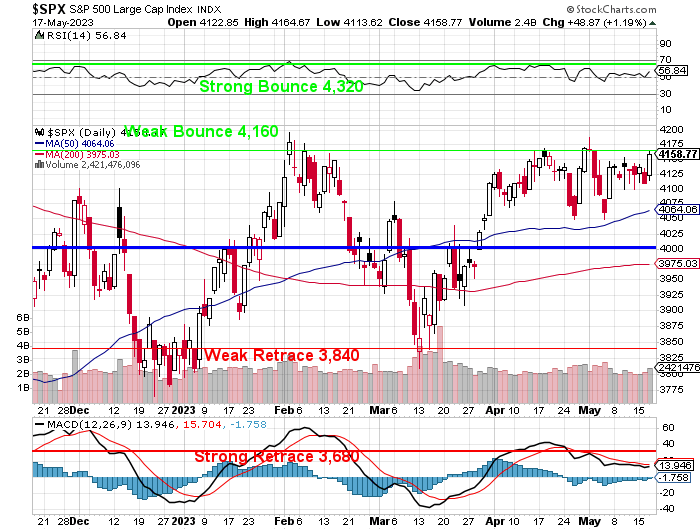And we’re back!

Will this be the breakout moment for the S&P 500? It’s been teasing our Strong Bounce line for a month and, when you consider that the 5% Rule™ is just something I made up – so relatively few people follow it – it’s pretty damned good proof that it works. Even more so as we aren’t even Technical Traders – so our own Members don’t use it as a major signal. It just so happens to be a true and reliable signal.
Well, we did cash out last month as I did not think we could get over that 4,160 line before earnings played out but now they are pretty much played out and, though we still have deep concerns about the market – we began adding positions to our Income Portfolio yesterday and now we’re going to begin to review candidates for the Long-Term and Short-Term Portfolios.
 As long as the S&P 500 are above 4,160 – we’re pretty comfortable going long again and, of course, we’ll begin adding hedges as well – just in case. We also have a nice indicator in the Nikkei 225, which just popped over 30,000 and, if this is a real rally – that should act as strong support.
As long as the S&P 500 are above 4,160 – we’re pretty comfortable going long again and, of course, we’ll begin adding hedges as well – just in case. We also have a nice indicator in the Nikkei 225, which just popped over 30,000 and, if this is a real rally – that should act as strong support.
We still have some overriding concerns – especially around CRE and the US Consumer’s ability to cope with inflation but there are still over 9M unfilled jobs – which means there is money out there for people who want it. Even if you say they are low-quality jobs – something is better than nothing when you need money.
There’s a huge underlying strain on Consumers and both TGT and WMT are saying that “shrinkage” (aka shoplifting) is a significant issue these days. Morality aside, people steal when they can’t afford to buy. While there are some high-profile gangs robbing stores (also caused by sweeping desperation in the lower classes), most shoplifting is lots and lots of people stealing lots and lots of things – Les Miserable x Millions.
I was asked to give an opinion to a Retailer recently and, unfortunately, it turns out that they brought this on themselves by automating the check-out lines – turning every shopping trip into an opportunity for larceny. This was a known issue from long before Covid but a lot of retailers plowed ahead anyway as the short-term savings of cutting check-out salaries seemed to outweigh “solvable” problems of cheaters.
Over 30% of Food Retailer transactions are now self-checkout. While there have been studies that suggest that self-service checkout technology may offer convenience and speed, it also helps turn law-abiding shoppers into petty thieves by giving them ready-made excuses to take items without paying for them. In the UK, surveys have revealed similar problems – one in five shoppers admit to regularly stealing when using the self-checkout.
After auditing 1 Million self-checkout transactions over the course of a year, totaling $21 million in sales, researchers found that nearly $850,000 (4%) worth of goods left the store without being scanned. That is far too much for Retailers like WMT or TGT or any Grocery Store – where margins are 3% of less.
 A typology of ‘swipers’
A typology of ‘swipers’
Research analyzing consumer checkout fraud divide “swipers” into four main groups.
1. Accidental
Many “swipers” claim that they originally stole by accident, but when they realised how easy it was, it became a regular habit. In a survey, 57% of those admitting to theft when using self-scan machines claimed that they first stole goods by accident or because they couldn’t get an item to scan. Those who are not apprehended or punished are likely to revise down their risk assessment and continue to commit offences, so creating a symbiotic spiral of escalating criminality.
2. Switching
Peanuts are cheaper than pine nuts, cooking tomatoes are cheaper than vine tomatoes, and of course, carrots are cheaper by weight than most other fruit and vegetables. Recognising this, many customers switch labels or deliberately input a different item on loose products. Perpetrators of this kind of “discount theft” do not necessarily view their actions as theft. Rather this behavior is perceived as “cheating” the system rather than stealing – or as a way of “gamifying” an otherwise mundane routine. Since switchers do pay something for the goods, they often don’t consider it to be “real” theft.
3. Compensating
Self-service usually results in fewer staff and more profits for the retailer, which for some “swipers” provides justification for their theft. Some customers believe that they should be “compensated” for having to process their shopping themselves when previously someone would have been paid to do it for them – it costs an estimated $1 (1%) to check out a $100 spent at the grocery store (just the top basket these days). Overall losses through customer theft might be seen as cheaper than the cost of paying cashiers – that is what led to widespread adoption of the systems but it turns out the system is creating ever more cheaters.
There are also ideological motivations: a resentment towards the growing automation of jobs, and the domination of large supermarkets over small community businesses. It’s difficult to ascertain whether this group genuinely consider shoplifting to be a political act, or whether this enables them to continue to perceive themselves as honest and moral individuals.
4. Irritated or frustrated
“Unexpected item in the bagging area” announces the machine accusingly as a red flashing light comes on. Perhaps unsurprisingly, self-service checkout is now considered one of the most irritating features of modern life. Those who steal through frustration believe it’s justifiable in response to their experience at the store, and draw upon a range of excuses, or what are known in criminological parlance as “techniques of neutralisation”. Justifications often include: “the item wouldn’t scan”, “the barcode was damaged” and “I couldn’t find the correct fruit or vegetable”. It’s difficult to know if the customer originally intended to pay for the item or whether self-service check-out invited this type of post hoc excuse making, also found among many burglars.
 5. Thrill Seekers
5. Thrill Seekers
Not all crime is rational or motivated by money. Some retail crimes are committed for more visceral reasons, such as armed robbers who get a kick out of the adrenalin, power and control, even when the rewards are minimal. Recognizing that transgression can be enjoyable provides some understanding as to why shoplifting is not solely the preserve of economically and socially disadvantaged groups stealing for subsistence.
Amazon Go concept stores were unveiled recently with a “Just Walk Out” approach to shopping, using AI technology to eliminate the need for checkouts without giving people a chance to cheat – though they still lose some percentage to error – AMZN feels that’s a small amount (which they will not disclose) and it’s fixable.
So a lot of the Retail wounds are self-inflicted but that doesn’t mean they aren’t real or can be ignored. Projected cost-savings by employee-cutting doesn’t always work out and that matters for overall profit projections going forward.
We’re still getting earnings from that sector and we will monitor it closely.







